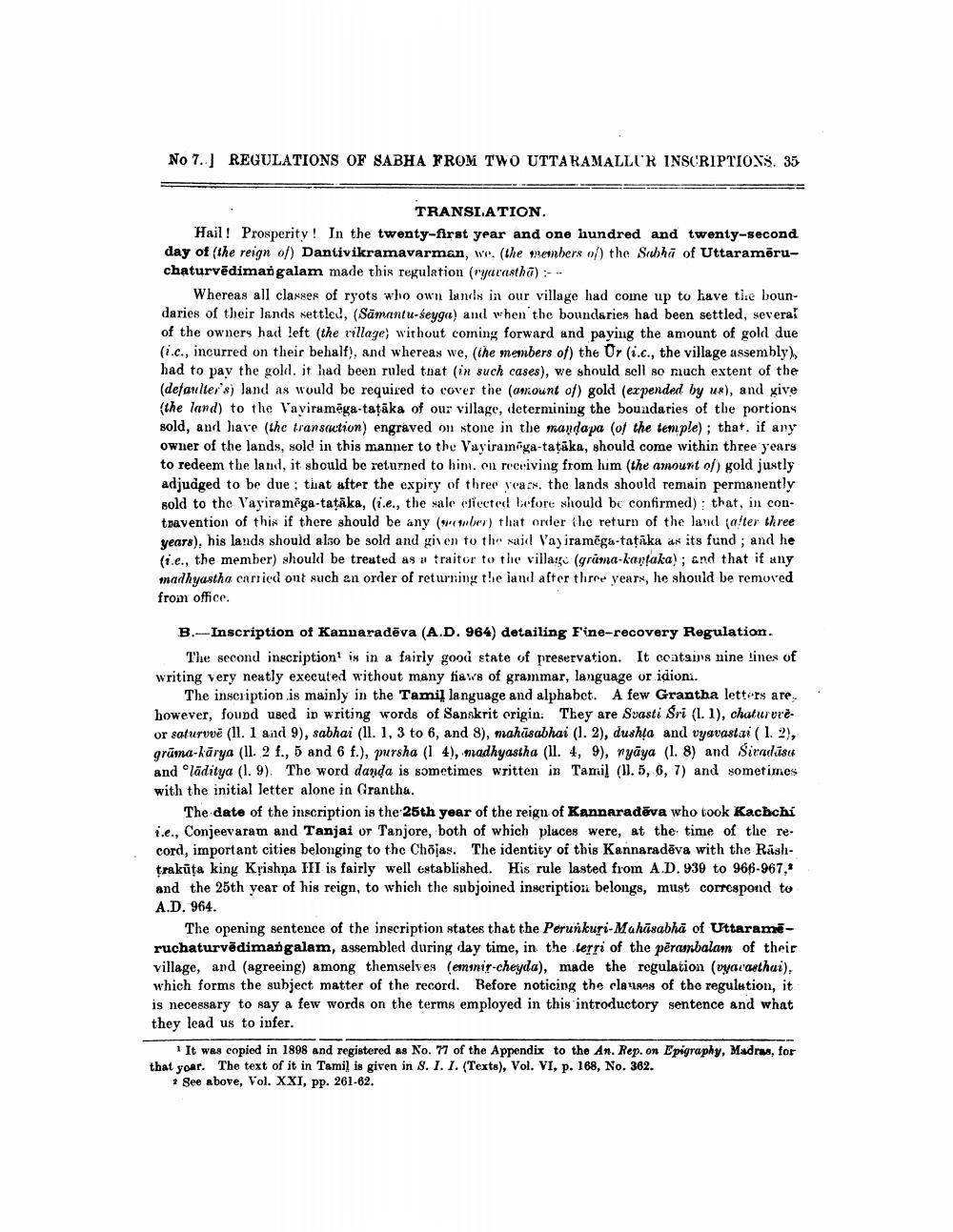________________
No 7..] REGULATIONS OF SABHA FROM TWO UTTARAMALLIR INSCRIPTIONS. 35
TRANSLATION. Hail! Prosperity! In the twenty-first year and one hundred and twenty-second day of the reign of) Dantivikramavarman, we. (the members of the Suha of Uttaramēruchaturvēdimangalam made this regulation (ryanstha) :--
Whereas all classes of ryots who own lands in our village had come up to have the boundaries of their lands settled, (Samantu-seyga) and when the boundaries had been settled, several of the owners had left the village, without coming forward and paying the amount of gold due (i.c., incurred on their behalf), and whereas we, (the members of the Or (i.c., the village assembly), had to pay the gold, it had been ruled that in such cases), we should sell so much extent of the (defaulter's) land as would be required to cover the amount of) gold (expended by us), and yive (the land) to the Vaviramėga-tațāka of our village, determining the boundaries of the portions sold, and have the transcution) engraved on stone in the mandapa (of the temple); that, if any owner of the lands, sold in this manner to the Vayiramnīga-tatāka, should come within three years to redeem the land, it should be returned to him. on receiving from him (the amount of) gold justly adjudged to be due: tisat after the expiry of three years, the lands should remain permanently sold to the Vayiraméga-tatāka, i.e., the sale effected before should be confirmed): that, in contravention of this if there should be any ember) that order the return of the land alter three years), his lands should also be sold and given to the said Vayiramēga-tațāka as its fund; and he (i.e., the member) should be treated as a traitor to the village (grāma-kantaka); and that if any madhyastha carried out such an order of returning the land after three years, he should be removed from office.
.
B.--Inscription of Kannaradēva (A.D. 964) detailing Fine-recovery Regulation.
The second inscription is in a fairly good state of preservation. It ccatairs nine lines of writing very neatly executed without many tiaws of grammar, language or idioni.
The inscription is mainly in the Tamil language and alphabet. A few Grantha letters are. however, found used in writing words of Sanskrit origin. They are Svasti Sri (1.1), chatururèor saturvvé (11. 1 and 9), sabhai (11. 1, 3 to 6, and 8), mahasabhai (1.2), dushịa and vyavastai (1.2), grūma-kārya (1l. 2 f., 5 and 6 f.), pursha (1 4), madhyastha (l. 4, 9), nyāya (1. 8) and Siradūsu and "lāditya (1. 9). The word danda is sometimes written in Tamil (11.5, 6, 7) and sometimes with the initial letter alone in Grantha.
The date of the inscription is the 25th year of the reign of Kannradēva who took Kachchi i.e., Conjeevaram and Tanjai or Tanjore, both of which places were, at the time of the re. cord, important cities belonging to the Chājas. The identity of this Kannaradēva with the Rashtrakūta king Krishna HII is fairly well established. His rule lasted from A.D. 939 to 966-967, and the 25th year of his reign, to which the subjoined inscription belongs, must correspond to A.D. 964.
The opening sentence of the inscription states that the Perunkuri-Mahasabha of Uttarameruchaturvēdimangalam, assembled during day time, in the terri of the pērambalan of their village, and (agreeing) among themselves (emmir-cheyda), made the regulation (vyavasthui), which forms the subject matter of the record. Before noticing the cla 1948 of the regulation, it is necessary to say a few words on the terms employed in this introductory sentence and what they lead us to infer.
* It was copied in 1898 and registered as No. 77 of the Appendix to the An. Rep. on Epigraphy, Madras, for that yoar. The text of it in Tamil is given in 8. I. 1. (Texts), Vol. VI, p. 168, No. 362.
* See above, Vol. XXI, pp. 261-62.




